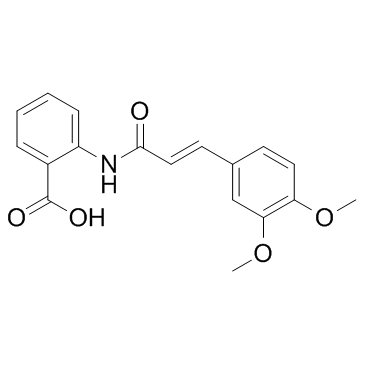trans-Tranilast |
| Catalog No.GC37819 |
trans-Tranilast (trans-MK-341) es un fÁrmaco antialérgico que se utiliza para tratar el asma bronquial, la rinitis alérgica y la dermatitis atÓpica.
Products are for research use only. Not for human use. We do not sell to patients.

Cas No.: 70806-55-2
Sample solution is provided at 25 µL, 10mM.
Tranilast (trans-) is an antiallergic drug, used to treat bronchial asthma, allergic rhinitis and atopic dermatitis.Target: Angiotensin ReceptorTranilast has been approved in Japan and South Korea, since 1982, for the treatment of bronchial asthma, with indications for keloids and hypertrophic scar added in 1993. Tranilast is also used to treat asthma, autoimmune diseases, atopic and fibrotic pathologies, and can also inhibit angiogenesis. The antiproliferative properties of tranilast were found that tranilast elicited an inhibitory effect on fibroblast proliferation in vitro and also suppressed collagen production both in vitro and in vivo . Tranilast also reduced the release of chemical mediators from mast cells and suppressed hypersensitivity reactions. [1]Three-week-old C57Bl/10 and mdx mice received tranilast (~300 mg/kg) in their food for 9 weeks, after which fibrosis was assessed through histological analyses, and functional properties of tibialis anterior muscles were assessed in situ and diaphragm muscle strips in vitro. Tranilast administration did not significantly alter the mass of any muscles in control or mdx mice, but it decreased fibrosis in the severely affected diaphragm muscle by 31% compared with untreated mdx mice (P< 0.05) [2].
[1]. Rogosnitzky, M., R. Danks, and E. Kardash, Therapeutic potential of tranilast, an anti-allergy drug, in proliferative disorders. Anticancer Res, 2012. 32(7): p. 2471-8. [2]. Swiderski, K., et al., Tranilast administration reduces fibrosis and improves fatigue resistance in muscles of mdx dystrophic mice. Fibrogenesis Tissue Repair, 2014. 7(1): p. 1.
Average Rating: 5 (Based on Reviews and 6 reference(s) in Google Scholar.)
GLPBIO products are for RESEARCH USE ONLY. Please make sure your review or question is research based.
Required fields are marked with *




















